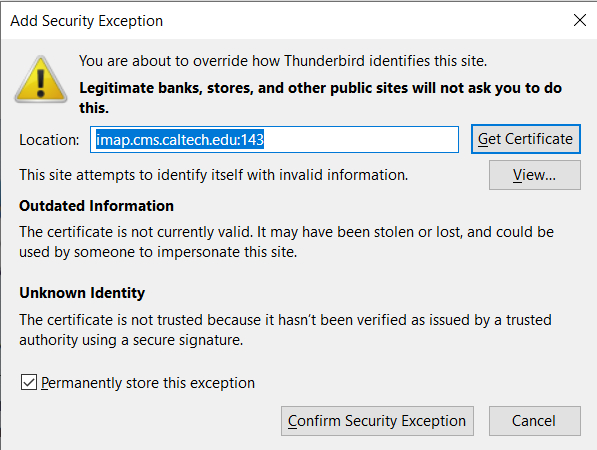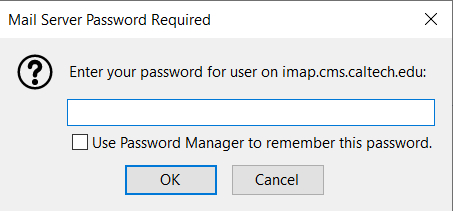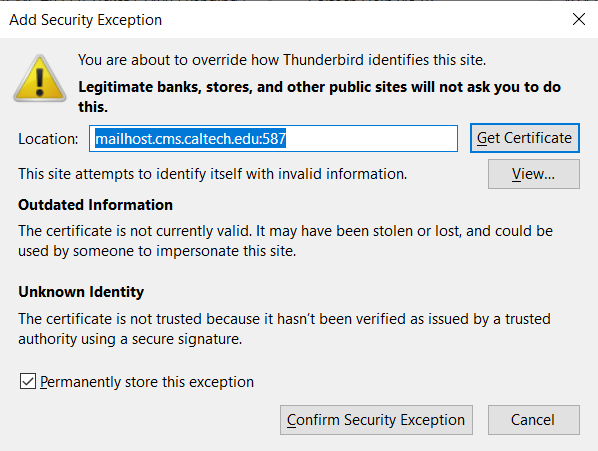How To Configure an IMAP Client to Read/Send CMS Email
This document assumes that you're reading your username@cms.caltech.edu email, and you're using it as your primary communication channel for business related to the Institute. By default, when CMS accounts are created, we forward your email to a destination address (usually your username@caltech.edu email address). However, for various reasons, some folks prefer to use their username@cms.caltech.edu address. While your user@caltech.edu address goes away when you leave the institute, your CMS email address can persist as a legacy forward. If you are going to publish your user@caltech.edu email address as your primary address, you should use that in the Caltech directory and on any other documents that require an email address, and simply don't use or publish your user@cms.caltech.edu email. Note: We do not recommend relying upon mail forwards for normal mail delivery. In the good ol' days, you could bounce email through several waypoints, forwarding email from one account to another. With the increasing volumes of spam over the years, mail server administrators have been forced to take more and more additional steps to lock down email to prevent systems from being flooded with spam. New antispam measures do sender-domain checks, Bayesian filters are triggered by "from" addresses not matching the sender address, and there are other countermeasures that make it more likely that legitimate mail will be flagged as spam somewhere along the delivery path. If you forward CMS email to some other destination, it has to pass through not only our spam scanning service but the spam scanning service of whatever destination address you use, which means misplaced mail can be misplaced in two different spam fitlers, etc. Now... If you're using CMS infrastructure, we recommend a fully standards-compliant IMAP client. The most common freeware version is Mozilla Thunderbird, so the directions below are for that email client. With small alterations they should work with most email clients available on Windows, Mac, Linux, or on mobile devices such as Android, or an iPhone.Step One:
Download and install Thunderbird. Make sure you get it from the Mozilla Foundation and not from another source, which may have adware installed.Step Two:
Run the Installer, and at the end of the installation process choose "Launch Thunderbird now". You will see the default Thunderbird window, along with a pop up window like this one:
Step Three:
You'll have to enter your name and email address. Once you do, the "Manual config" button will be enabled: Clicking on the "Manual config" button expands the window and enables you to fill out all of the relevant fields.
Clicking on the "Manual config" button expands the window and enables you to fill out all of the relevant fields.
Step Four:
You want to fill out that window as below, substituting in your name and your CMS account name where appropriate: (The configuration information shown above is the relevant infomation for a phone client or other desktop email client. The incoming server is an IMAP server, named "imap.cms.caltech.edu", listening on port 143, with the STARTTLS encryption mechanism. The outgoing server is an SMTP server, named "mailhost.cms.caltech.edu", listening on port 587, also with the STARTTLS encryption mechanism.)
After you've entered in the information above, hit the "Done" button. This will take you back to the regular Thunderbird screen, and you will see your Inbox, but without any messages yet.
(The configuration information shown above is the relevant infomation for a phone client or other desktop email client. The incoming server is an IMAP server, named "imap.cms.caltech.edu", listening on port 143, with the STARTTLS encryption mechanism. The outgoing server is an SMTP server, named "mailhost.cms.caltech.edu", listening on port 587, also with the STARTTLS encryption mechanism.)
After you've entered in the information above, hit the "Done" button. This will take you back to the regular Thunderbird screen, and you will see your Inbox, but without any messages yet.
Step Five:
Click on the "Get Messages" button to start your first connection to the mail server. When you do, this window will appear: CMS uses a self-signed SSL certificate for both incoming and outgoing email (we do this to avoid paying Verisign or another Certificate Authority for a CA-signed cert). Although this window looks scary, this is expected.
CMS uses a self-signed SSL certificate for both incoming and outgoing email (we do this to avoid paying Verisign or another Certificate Authority for a CA-signed cert). Although this window looks scary, this is expected.
Step Six:
Click on the "Confirm Security Exception" button, and Thunderbird will prompt you for your password: Type in your CMS password (click the box to have the Password Manager remember it if you don't want Thunderbird to ask you every time you get email), and hit "OK".
Once your email Inbox syncs, you need to send yourself a test email to finish configuring outgoing email.
Type in your CMS password (click the box to have the Password Manager remember it if you don't want Thunderbird to ask you every time you get email), and hit "OK".
Once your email Inbox syncs, you need to send yourself a test email to finish configuring outgoing email.
Step Seven:
Click on "Write", and compose yourself a short email, addressing it to your CMS email address. Hit "Send". When you do, this window will pop up (warning, some editions of Thunderbird this window pops up behind the main window, and you'll have to shrink the Thunderbird window to see it): Again, hit "Confirm Security Exception" to save the certificate in your certificate store.
This will return you to the main screen.
Again, hit "Confirm Security Exception" to save the certificate in your certificate store.
This will return you to the main screen.
Step Eight:
You may or may not see this pop up: If you do, just hit "OK" and then hit "Send" on the email again. The message should sail through, and wind up back in your Inbox.
-- PatrickCahalan - 2020-04-06
If you do, just hit "OK" and then hit "Send" on the email again. The message should sail through, and wind up back in your Inbox.
-- PatrickCahalan - 2020-04-06| I | Attachment | Action | Size |
Date | Who | Comment |
|---|---|---|---|---|---|---|
| |
Five.jpg | manage | 60 K | 2020-04-06 - 20:55 | PatrickCahalan | screenshot-five-thunderbird |
| |
Seven.jpg | manage | 60 K | 2020-04-06 - 20:55 | PatrickCahalan | screenshot-seven-thunderbird |
| |
One.jpg | manage | 79 K | 2020-04-06 - 20:53 | PatrickCahalan | screenshot-one-thunderbird |
| |
Two.jpg | manage | 120 K | 2020-04-06 - 20:54 | PatrickCahalan | screenshot-two-thunderbird |
| |
Three.jpg | manage | 160 K | 2020-04-06 - 20:54 | PatrickCahalan | screenshot-three-thunderbird |
| |
Six.jpg | manage | 204 K | 2020-04-06 - 20:55 | PatrickCahalan | screenshot-six-thunderbird |
| |
Four.jpg | manage | 213 K | 2020-04-06 - 20:55 | PatrickCahalan | screenshot-four-thunderbird |
Ideas, requests, problems regarding CMS Wiki? Send feedback

